
Guests
- John Carlos Freyinvestigative reporter working on behalf of the Investigative Fund at The Nation Institute. His piece, Dying to Get Back, which aired on PBS Need to Know last month, has just won the June Sidney award for socially conscious journalism from the Sidney Hillman Foundation. It’s the third part in a three-part series called Crossing the Line at the Border.
As the Senate begins debate over border enforcement in the immigration reform bill, we look at the human cost of militarization of the border. The award-winning PBS documentary “Crossing the Line at the Border: Dying to Get Back,” tells the story of Alfonso Martinez Sanchez, a 39-year-old father of five U.S.-born children. After being deported last year, Alfonso got heat stroke while attempting to re-enter the U.S. through the Arizona desert to reunite with his children. He later died after Border Patrol agents refused to heed his friend’s pleas to help him. Reporter John Carlos Frey of The Nation Institute’s Investigative Fund joins us to discuss Sanchez’s story and the lessons it holds for the Senate’s debate over immigration reform.
Transcript
JUAN GONZÁLEZ: On Wednesday, the Senate began debate on an immigration reform bill that has at its core a pathway to citizenship for some 11 million immigrants now living in the shadows. But several senators say border security will have to be strengthened in order for it to pass. Already, the current bill would require the Department of Homeland Security to extend border fencing and achieve “effective control” of the Southwest border, defined as continuous surveillance along its entire length and 90 percent effectiveness in stopping illegal crossings. Only once those goals are fulfilled could undocumented immigrants apply for provisional status.
AMY GOODMAN: Well, today we look at the human cost of militarizing the border. This is a clip from a documentary called Dying to Get Back that aired last month on PBS’s Need to Know. It’s the third in a three-part series called Crossing the Line at the Border, and it tells the story of Alfonso Martinez Sanchez, a 39-year-old father of five U.S.-born children. After being deported, Alfonso gets heat stroke while attempting to re-enter the United States through the Arizona desert to reunite with his kids. PBS correspondent John Larson explains how Alfonso’s friend and fellow migrant, Isaac, tried to save him.
JOHN LARSON: Two hours after Alfonso falls ill, Isaac builds a large signal fire to attract the Border Patrol, so Alfonso can be saved. But no luck.
ISAAC: [translated] I thought about staying there with him until sunrise, but I said to myself, “I have to look for help.”
JOHN LARSON: He climbs the nearest ridge, hoping to get to a cell signal on Alfonso’s phone.
ISAAC: [translated] And I turned it on, and I implored God. I said, “My god, help him.”
JOHN LARSON: He miraculously gets a signal. Soon after, two Border Patrol officers arrive in a truck. Isaac says he tells them they must quickly go together to rescue Alfonso, and tells them exactly where he is. Instead, they arrest him and immediately take Isaac to detention, assuring him that other agents were searching for Alfonso and would rescue him. Thad Bingel, the former chief of staff of Customs and Border Protection, says that if Isaac’s story is true, the agents did not act properly.
THAD BINGEL: It’d be very unusual if they thought the person with them was trying to help them identify a location, that they wouldn’t take advantage of that information. That would not be normal protocol.
JOHN LARSON: Two-and-a-half days after Alfonso got sick, Isaac is deported to Mexico. He immediately calls Alfonso’s family.
GLADYS DOMINGUEZ: Well, in my head, I thought, OK, it’s Saturday night, Sunday, Monday, Tuesday. If he managed to find a tree, stay under the tree, and if he had a little bit of water, he could have stayed alive there.
JOHN LARSON: Alfonso’s daughter Gladys, an American citizen, makes dozens of frantic phone calls to the Border Patrol in Arizona, asking if her father is detained or in the hospital. She says the Border Patrol gives her no answers.
How long was it until somebody said, “OK, here’s exactly who you need to call. Maybe they can help”?
GLADYS DOMINGUEZ: They didn’t say that. They didn’t say that. I kept on researching on the Internet ’til I found BORSTAR.
JOHN LARSON: BORSTAR, the Border Patrol Search, Trauma and Rescue unit.
BORDER PATROL VIDEO: This is the part of U.S. Customs and Border Protection’s mission that rarely makes headlines: rescuing those in trouble along our southern border.
JOHN LARSON: Its mission, to “provide life saving aid” to the “distressed … migrants along the border.”
THAD BINGEL: It’s pretty rare for a law enforcement agency to basically create a rescue unit just to deal with people who are basically engaged in illegal activity, of crossing the border, in a humanitarian way.
JOHN LARSON: So Gladys calls BORSTAR and tells them her father is dying in the desert. But Gladys says, when she called, she was put on hold, transferred, or told to talk to someone else. Finally, four-and-a-half days after Alfonso fell ill, the Border Patrol meets Isaac at the border and takes him to rescue his friend in the desert. Once they arrive in the area and start walking, it takes just 45 minutes to locate Alfonso.
ISAAC: [translated] It was the hardest thing for me, because of how I left him and how I found him.
JOHN LARSON: Alfonso was later identified by his dental records and personal items. His jacket, watch, keychain all wound up as exhibits in that Pima County morgue. His body was found exactly where Isaac had left him, exactly where he says he had told Border Patrol agents almost five days earlier to search for him.
I have the toughest question for you: Do you ever think about those last hours, of what must have been going through his mind?
GLADYS DOMINGUEZ: Every day. I think about it every day.
JOHN LARSON: What do you think he was thinking?
GLADYS DOMINGUEZ: Because the last thing—Isaac called us, and he told us, “When your dad was dying, the only thing he was saying was 'I don't want to die. I don’t want to die. I want to go back to my kids. I want to make it with my kids. I have to make it with my kids. I need to get back.’”
AMY GOODMAN: That was Gladys Dominguez, daughter of Alfonso Martinez Sanchez, from the PBS Need to Know documentary called Dying to Get Back, which just won the Sidney Hillman award for socially conscious journalism. It’s the third part in a three-part series by John Carlos Frey called Crossing the Line at the Border. John Carlos Frey now joins us from Los Angeles, investigative reporter working on behalf of the Investigative Fund at The Nation Institute.
Welcome to Democracy Now! Can you talk about the case of Alfonso Martinez Sanchez and how it relates to the current debate on the immigration reform bill?
JOHN CARLOS FREY: Sure. Thank you, and good morning, Amy and Juan.
The story is obviously just tragic. We have a system now where we import labor surreptitiously across the U.S.-Mexico border, but we don’t give these individuals a legal means to get here. We deport fathers and wives and sometimes children of families that are of mixed status, some U.S. citizens, and we don’t provide any form of legal means for these individuals to normalize their status. So we’re asking people, if we deport them, to stay separated from their family members. What you’re basically doing is creating a system of furthering illegality. Who wouldn’t, in their right mind, want to cross the U.S.-Mexico border illegally to reunite with their family? This is the system we have in place.
If Alfonso Martinez Sanchez actually had legal recourse in the United States, he could have petitioned to speak to a judge to be—to have his case heard in immigration court. But he wasn’t given that choice. He was deported en masse with hundreds of thousands of other deportees that the Obama administration has furthered, and these individuals are left with no recourse but to try to get back to their families. If we increase border security, it’s pretty well noted that this system of individuals crossing treacherous terrain, like Alfonso, is going to continue. And that’s not a part of the immigration reform bill, as far as I can see, is taking a look at the human toll.
JUAN GONZÁLEZ: Well, John Carlos, one of the things that the—at least the proposal of the so-called Gang of Eight would do is it would allocate up to $5 billion for additional border security, and lots of defense contractors are lining up already to be moving into this area of border security and militarization of the border. But that’s probably going to be even more, once the changes are made by the Republicans in the Senate or even in the House. So, what’s going to be the impact of this increased militarization along the border?
JOHN CARLOS FREY: If you take a look at the impact of militarization prior to today, it’s pretty clear that once border fences and the increase in border guards began a little over a decade ago, that the incidence of death along the U.S.-Mexico border skyrocketed. So, if you extrapolate out to today, you can say that more of the same is going to give you more of the same. The U.S.-Mexico border is fortified. There is over 700 miles of border fence. We have 20,000 border guards along the U.S.-Mexico border. There are Black Hawk helicopters. There are night sensors. There are a heat sensors. It looks like a militarized zone. And still, with that setup, with that infrastructure, last year it was estimated that over 350,000 undocumented immigrants actually crossed that U.S.-Mexico border without being detected. So, I’m not quite sure if we do more of the same that it’s going to be effective.
The thing that urges people to cross the U.S.-Mexico border is twofold. It’s to reunite with family members, and it’s economic necessity. Those issues are not being addressed in this immigration reform bill. In addition to that, over 40 percent of the undocumented immigrants in the United States actually never cross that U.S.-Mexico border without documentation. Over 40 percent of the undocumented immigrants in the United States actually came legally with a visa, and the visas have expired, and they’re continuing to live within the confines of the United States. That issue is not being addressed. So, I can’t quite say that throwing more money at the U.S.-Mexico border is going to alleviate undocumented immigration.
JUAN GONZÁLEZ: I want to go to another clip from the PBS Need to Know documentary Crossing the Line at the Border: Dying to Get Back. Here, reporter John Larson describes a U.S. immigration policy change called Prevention Through Deterrence, which began in 1994.
JOHN LARSON: The strategy was not just to keep people out, but to funnel those who made it across the border into the desert, into “more hostile terrain, less suited for crossing and more suited for enforcement,” where they might be easier to catch. As a U.S. Border Patrol video shown to the public in 2009 put it:
BORDER PATROL VIDEO: We now have the tactical advantage, and we only need to exploit that advantage.
JUAN GONZÁLEZ: Those are the U.S. Border Patrol’s own words, quote: “We now have the tactical advantage, and we only need to exploit that advantage.” Before that, you heard a direct quote from a Border Patrol document: “more hostile terrain, less suited for crossing and more suited for enforcement.” John Carlos Frey, talk more about the Border Patrol strategy of Prevention Through Deterrence.
JOHN CARLOS FREY: These are two documents, the video and the actual document itself, that I was able to obtain. They weren’t necessarily released to the public. As a matter of fact, the video itself, I shot in a conference that the U.S. Border Patrol was having, and this was up on their screen, and I actually shot that clip with my own hidden camera. This is policy. This is protocol that the U.S. Border Patrol does not publicize. They actually seal off cities along the U.S.-Mexico border, large cities like El Paso, Nogales or San Diego, and they keep the deserts open. They actually do not fence, they do not patrol as much these open areas of treacherous terrain on purpose, inviting migrants to cross there because they believe that they will have the tactical advantage if migrants are out in the open or if they’re weakened or if they’re slowed down. They’re much easier to detect in wide-open areas, especially in the desert, where there’s no brush and where there’s no coverage. So, this is actually part of U.S. Border Patrol policy, to allow migrants to cross treacherous terrain. In addition to that, this deterrence policy is to try and make this journey for migrants as difficult as possible, because they believe, if they try to attempt again, they’re going to think about it. They’re going to think about the journey that they just tried. Maybe they’ll go back to their home country and tell their friends and their family, “Don’t try this. This is too difficult.” This deterrence policy doesn’t seem to be working for those individuals who are desperate.
AMY GOODMAN: John Carlos, I recently spoke to Shena Gutierrez, a volunteer with Southern [Border Communities] Coalition, who had a very personal experience related to the border: her husband nearly killed in an encounter with Border Patrol agents. While still unconscious in the hospital, he was threatened with deportation. She explained what happened.
SHENA GUTIERREZ: Two years ago, March 30th—he was deported to Mexico March 21st. And, you know, he was desperate. You know, we have two young children. At the time, our son was two and a half; our daughter was only four months old. And our daughter was in the hospital. And he was deported, and he was just trying to figure out how to get back to us. March 30th, he attempted to cross back, and I lost contact with him that day. Wednesday, Thursday, Friday go by. By Saturday, I’m completely going insane, not knowing what happened, where he’s at, if he’s alive, if he’s OK. I mean, it just wasn’t like him to not call me and let me know what was going on.
I get a call from the consulate in Arizona asking me, you know, “Is this Shena, who’s his wife?” I said, “Yes.” And I will never forget those words. She says, “Well, we have to inform you that there’s been an accident.” I had no idea what kind of accident she meant. After numerous phone calls, hours later, I find out he’s in Phoenix, and they tell me he’s unconscious. I get to the hospital, and in my mind I’m thinking, you know, “Unconscious: He’s laying in a bed with maybe an IV in his arm, and that’s it, at the most.” And when I turn the corner and I see the two agents—because he was being protected, 24 hours a day, seven days a week, by agents at the door—they stand up, and I notice gun on one side and taser on the other side. And I just kind of peek into his room, and I fall, because he had staples ear to ear, black and blue all over his body. He had machines all over him. And he was in a straight-up coma.
AMY GOODMAN: That was Shena Gutierrez describing what happened to her husband in his encounter with border police. John Carlos Frey, you know this story well. Can you wrap up by telling us what happened to him?
JOHN CARLOS FREY: This man was brutally beaten. I saw him days after he was beaten. There’s no doubt. His teeth were misaligned. He had bruises all over his body. The horrible thing here is that, to this day—this happened a year-and-a-half ago, almost two years ago—we still don’t know the agents involved. We don’t know why he was beaten. He wasn’t arrested. He’s still in the United States. This issue here has not been addressed. This brutal beating has basically been swept under the rug. And that’s the problem here with trying to increase the force and increase border security infrastructure. There’s no oversight. Nobody is really minding the store. There’s no accountability. If these Border Patrol agents actually beat Mr. Gutierrez, as it looks as if they did, where’s the accountability? And there doesn’t seem to be any scrutiny. We don’t have any sort of a congressional or governmental oversight committee that’s taking a look at these incidents. As a matter of fact, most of these incidents are investigated internally. The Border Patrol usually ends up investigating itself. So if we’re going to increase the size of the force and its infrastructure, I think that Congress should add to the bill some sort of oversight, some sort of accountability and some form of scrutiny, which is absent.
AMY GOODMAN: John Carlos Frey, I want to thank you for being with us, investigative reporter working on behalf of the Investigative Fund of The Nation Institute. His piece, Dying to Get Back, which aired at PBS Need to Know, has just won the June Sidney award for socially conscious journalism from the Sidney Hillman Foundation. It’s part of the three-part series called Crossing the Line at the Border. And at our website, democracynow.org, we’ll link to the full conversation that talks about Shena Gutierrez’s husband and what happened to him. That’s at democracynow.org.

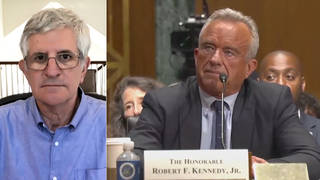
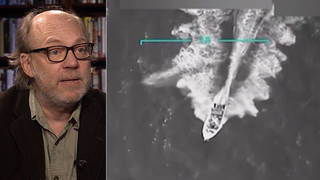
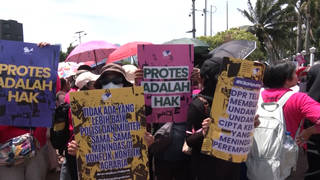

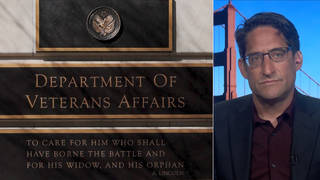
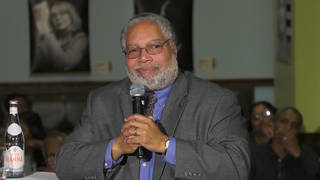



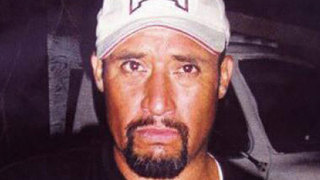
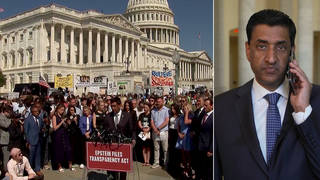
Media Options